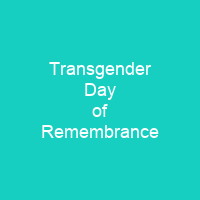Transgender Day of Remembrance was founded in 1999 by Gwendolyn Ann Smith. In 2010, TDoR was observed in over 185 cities throughout more than 20 countries. Scholar Sarah Lamble argues that T doR’s focus on a collective mourning risks producing the white spectator as innocent of, rather than complicit in, the violence that produces the deaths of trans women of color.
About Transgender Day of Remembrance in brief

Theorists C. Riley Snorton and Jin Haritaworn critique how images and narratives centering on trans people of color are circulated within social movements and spaces headed by white gay and trans activists. In 2020, US President-elect Joe Biden said the transphobic violence experienced by trans women is intolerable and that the day should be a moment of silence for those who have been murdered as a result of transphobia.
You want to know more about Transgender Day of Remembrance?
This page is based on the article Transgender Day of Remembrance published in Wikipedia (as of Dec. 06, 2020) and was automatically summarized using artificial intelligence.







